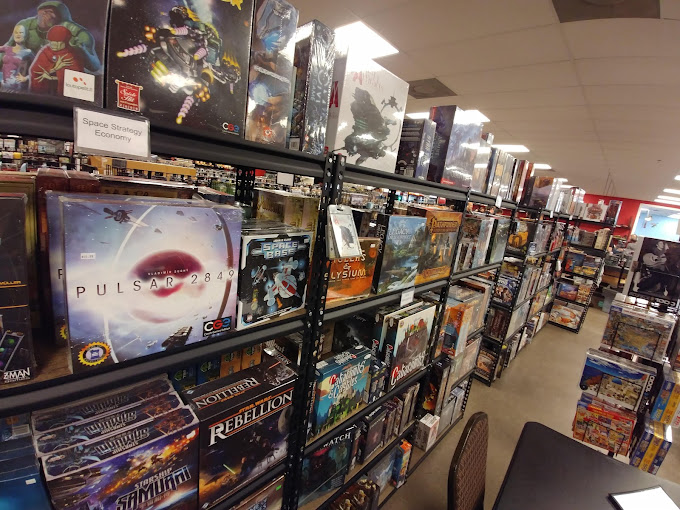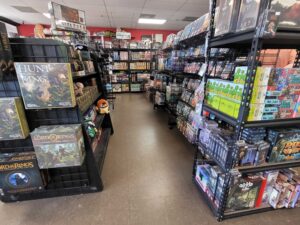You’ve finished the game, after hours and weeks of painstaking playtesting and design. The next thing you know, it’s funded! The dream has become a reality and you’ve got backers excited to get their copy, fulfillment goes smoothly, and now you’re looking at the leftover stock. Of course, the logical next step for most publishers is to put the game into the wholesale markets, so that it can sit happily on the shelves of game stores around the world.
And then, sales trickle in. Sure, maybe you’re selling one or two copies a week, but compared to the initial crowdfunding buzz, it hardly seems worth it. What’s going on?
For 90% of publishers, simply putting your game into distribution to retailers is only a first step. Think of it like this: you make salsa, and Walmart stocks your salsa on their shelves. However, aside from possibly including your salsa in an email, and maybe in a printed mailer, Walmart isn’t advertising your product specifically and constantly, and unless you’re paying for more insertions or online spots, they never will.

Your game may be competing with a hundred others. How are you standing out?
But wait, hundreds of people a day are seeing the salsa, why isn’t anyone buying? For one, you’re competing with at least a dozen other brands, some with big name recognition, and if you’re plan is to simply put the salsa on the shelf and hope it works…well, hopefully you really like your own product, because it’ll eventually be moved off in favor of something that sells. Get the chips ready, and clear out some space in your garage.
Besides making you hungry, the above example is the same concept as sending your game to a distributor, and then wondering why stores aren’t purchasing it in droves. Sure, some come across it organically, and most distributors (including Bridge) will cycle through products in solicitations (we even create a special ‘spotlight’ email that goes out to our retailers twice per product arrival). Maybe you’re one of the lucky ones where the game continues to generate buzz, and stores are eager to have it in stock.
But just as it isn’t Walmart’s job to advertise your salsa, neither is it the distributor’s job to push your game exclusively, as they have dozens of other salsas to tango with (or in our case, hundreds of other games).

The average game store customer has a slew of titles to browse, and often, has entered the store already knowing what they want.
That being said, we’re often asked the question that gave this article it’s title: Why isn’t my board game selling? The answer is, of course; how are you promoting it? There are plenty of options to keep your game in the eyes of your customers, drive better retail sales, and overall see a return on the project you worked to hard to create. So many, in fact, that we’ll be breaking this out into a few articles, with this one focused on the thing everyone either loves or hates:
Social Media
It seems like an obvious question to ask, but are you maintaining a strong social media presence? More than just making the occasional post with the same pictures you’ve used since the game launch, are you engaging with the community? You might consider creating a group specifically for your brand/game, and inviting your crowdfunding community to join. The more people in the group, the more Facebook will recommend it to others, and the more people are seeing the name of your product. Plus, it’s a great way to grow organically, as people might join to learn more before purchasing the game (especially important if you’re selling a 70$ luxury product).
Need some ideas for posts? Here are a few we’ve seen be effective in the past.
Character bios and artwork – Who is the mystery spaceman on the front of the box? If your game allows for an RPG element, finding out a little more about Malavith the Necromancer, with a few pieces of art (show off concepts and sketches too!) will get potential players more interested in your game.
Development Diary – The game may be published, but how did it get there? What did the first prototypes look like? Was there a feature or mechanic that didn’t make it into the game? Not only is this great content, it’s also a sneaky way to judge interest in expansion materials. If people are excited about something that wasn’t included in the first game, you’ve got a great idea for an add-on already developed.
New ideas for format – A lot of games can be played in new, different ways than the initial ruleset may explain. What happens if you give every player double the starting life points? How fun is it to let each player start the game with a rocket launcher? Magic: The Gathering (you might have heard of it) is a prime example of taking player-made ways to play and turning them into official formats, so let your community tell you how they like playing your game.
Next time, we’ll get into some more complex topics, such as keyword advertising and ad placement. Please feel free to comment about what you’d like to see next!

Well done, I work for sound of drums, we make historical board wargames, what’s the best way to convince retailers with a store full of magic, Warhammer, star wars etc to but eylau 1807, battle commander, or patriots and traitors, when they see historical wargames are their eyes just going to glaze over? I’ve had some success in miniatures, sentry box, noble knights games though